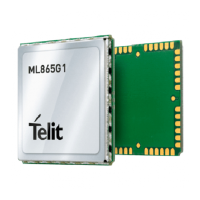ML865G1 HW Design Guide
1VV0301632 Rev. 4 Page 59 of 86 2020-09-23
• Keep line on the PCB as short as possible, since the antenna line loss shall be less
than about 0,3 dB;
• Line geometry should have uniform characteristics, constant cross section, avoid
meanders and abrupt curves;
• Any kind of suitable geometry / structure (Microstrip, Stripline, Coplanar, Grounded
Coplanar Waveguide...) can be used for implementing the printed transmission line
afferent the antenna;
• If a Ground plane is required in line geometry, that plane has to be continuous and
sufficiently extended, so the geometry can be as similar as possible to the related
canonical model;
• Keep, if possible, at least one layer of the PCB used only for the Ground plane; If
possible, use this layer as reference Ground plane for the transmission line;
• It is wise to surround (on both sides) the PCB transmission line with Ground, avoid
having other signal tracks facing directly the antenna line track.
• Avoid crossing any un-shielded transmission line footprint with other signal tracks
on different layers;
• The ground surrounding the antenna line on PCB has to be strictly connected to the
main Ground Plane by means of via holes (once per 2mm at least), placed close to
the ground edges facing line track;
• Place EM noisy devices as far as possible from ML865G1 antenna line;
• Keep the antenna line far away from the ML865G1 power supply lines;
• If EM noisy devices (such as fast switching ICs, LCD and so on) are present on the
PCB hosting the ML865, take care of the shielding of the antenna line by burying it
in an inner layer of PCB and surround it with Ground planes, or shield it with a metal
frame cover.
• If EM noisy devices are not present around the line, the use of geometries like
Microstrip or Grounded Coplanar Waveguide has to be preferred, since they
typically ensure less attenuation if compared to a Stripline having same length;
The following image is showing the suggested layout for the Antenna pad
connection:

